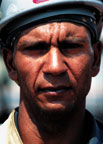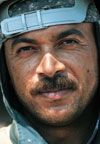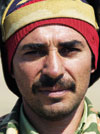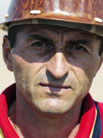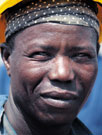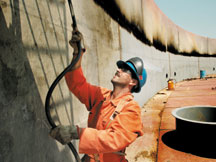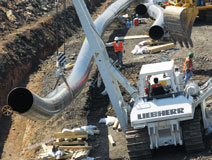|
Above: The BTC construction work come from many countries, but the majority are locally recruited as a policy of the project. The Baku-Tbilisi-Ceyhan oil pipeline is now becoming reality - day by day, kilometre by kilometre - at 17 different locations along its lengthy route. At the beginning of September 2003, five weeks after the first welded sections of pipe were laid in a specially-prepared trench close to the Sangachal Oil and Gas Terminal in Azerbaijan, about 20 km of the pipeline had already been welded and lowered in place. Site preparation for the eight pump stations, being positioned on the 1,760 km route, was well advanced. The majority of pipe needed for the project had been delivered to strategically placed pipeyards. At Ceyhan (pronounced Jeyhan), a Turkish port on the Mediterranean Sea, work was well advanced on the terminal's upgrade, including excavations for seven new tanks.
Above: (top left and rigt) 1. David Kikodze, director of the rare plant conservation project at the botanical garden at Bakuriani, Georgia. 2. Construction of the BTC facilities at Sangachal Terminal near Baku. (bottom left and right): 3. Crude oil storage tanks under construction at Sangachal Terminal. 4. Laying pipe in Azerbaijan. By the end of 2004, major construction will be completed. By 2010, the link - the longest pipeline ever sponsored or operated by BP - will be carrying 1 million barrels of oil a day (about 50 million tonnes) from the Caspian Sea to international markets via Ceyhan and the Mediterranean. Already some impressive achievements are being chalked up by this massive project that will cost around $3 billion and employ 10,000 workers at its peak towards the end of 2003. · Up to 1,000 individuals a month are now being mobilized to join the construction workforce. The overall goal is that more than 70 percent of workers will be recruited locally. Each worker is being trained to do the job safely. · Equipment is being purchased from all over the world and transported from 13 different countries to the BTC region. There the equipment is distributed to work camps along the route in a move coordinated from 30 office locations around the world. · Around 150,000 sections of pipe, each 11.5 meters long, are being laid out along the narrow "right-of-way" corridor. · Spending on the project reached $4 million a day in July. All told, the 11-partner consortium that makes up the BTC Company expects to spend $2 billion in capital investment during 2003. · Overall BTC construction was nearly 40 percent complete at the start of September if measured by amount of funds that have been spent. How these statistics translate into progress on the ground can be gauged at PSG2 - the site of one of two pump stations being constructed in Georgia at a combined cost of $95 million. Below: Twelve-metre lengths of pipe strung out ready for welding along the BTC route in central Georgia.  To construct PSG2, the site first had to be leveled. Doing this has involved huge earthworks and the shifting of massive amounts of topsoil and rock. Some of the topsoil has been moved and used to make a new football field in Tetriskaro. Nearly 700 trees of 30 different species have been cut down; the great majority will be replaced once construction is finished. Some of the wood has been distributed to local charities, including an orphanage, in anticipation of the winter, Eventually the entire site will be ringed by a three-meter high security fence. Just down the road on a sloping site closer to Tetriskaro, a $2 million, 385-person camp has been erected for the PSG2 workers. The entire project took five months to complete. It included drilling a well (water was found at 101 meters) and putting in roads. Facilities include residential quarters, recreational areas, diesel storage tanks, incinerators and generators. At both of these worksites, the watchword is "Safety First". For many of the work crews, it is the first time they have encountered international construction standards and practices. Recently, at a monthly ceremony to reward outstanding safety performance, a site manager named Tito made a point that registered widely. "Remember," he said, "we work not only for money but for our families and our future. We all want to return home safely." With winter now fast approaching, the aim at PSG2 is to complete leveling the site and to get as much of the concrete foundation poured as is possible before snow falls. At that time, PSG2 will go into hibernation and its workers will move on to lower altitudes until spring. The Local Dimension From one end of the BTC route to the other, increasing numbers of local people and firms are starting to benefit from the project - either directly through jobs, or indirectly by providing goods and services to the project.  An estimated 80 percent of the construction work is being done by locally hired employees. This includes developing offshore fields in the Caspian Sea, constructing the Sangachal Oil and Gas Terminal south of Baku, upgrading the Ceyhan Terminal in Turkey, and building the pipeline between the two terminals. At its peak in 2004, the BTC project expects to employ 10,000 construction workers: 2,300 Azerbaijanis, 2,500 Georgians and about 5,000 Turks. By September 2003, an estimated 3,000 local jobs had already been created. At the same time, local companies are providing much food , mobile phones, furniture, stationery, water tanks, safety gear and computers. For example, more than 190 local companies - most of which are small or medium-sized - are already involved with BP in Azerbaijan. Three-quarters of them do business with the BTC project. Hundreds more are winning contracts through the major contractors and partners - CCIC (Consolidated Contractors International Company) in Azerbaijan, Spie Capag/Petrofac in Georgia and BOTASH in Turkey. Offshore, a similar story can be told in regard to local Azerbaijan companies which are supporting much of the current surge of development activity in the Caspian. Pipelaying operations, for instance, involve facilities owned by SOCAR, the SPS shipyards, EUPEC Pipecoatings joint venture with AZPETROL, the KMNF Marine Alliances, and numerous others. In each of the three countries - Azerbaijan, Georgia and Turkey, goals are in place to raise the proportion of goods and services purchased locally. BP Azerbaijan boosted its business with local firms by 36 percent in 2002. This year it aims to further increase business by another 50 percent. 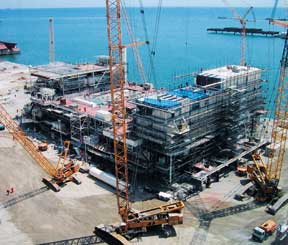 Ramping Up Offshore If there were no product to pump, neither the BTC oil pipeline nor the associated South Caucasus Natural Gas Pipeline would exist. So the significance of mounting activity offshore and onshore Azerbaijan is difficult to underestimate. For the BTC project, preparations to start production at the beginning of 2005 from the offshore Central Azeri field - a key element of the linked Azeri-Chirag-Gunashli (ACG) deposits - are critical to its success. Construction works at Central Azeri are now two-thirds complete. The pre-drilling programme, including completion of 12 pre-drill wells was finished 130 days ahead of schedule, a pipelay barge has been upgraded and sea trials for it and other marine support vessels have begun. Subsea pipelaying is now underway. Pre-drilling activities on the nearby West Azeri field began at the end of May and are expected to be completed well before their June 2004 target date. The upgraded pipelay barge known as Israfil Huseynov will be used for implementation of the entire Azeri project subsea pipelaying programme. This is a major undertaking with over 600 km of pipe to be laid at water depths ranging up to 180 meters. It includes two oil pipelines and a gas pipeline to the Sangachal Terminal. Meantime basic engineering studies continue for the development of the deepwater Gunashli portion of the ACG field. First Oil from this project is targeted for mid-2008, allowing ACG production for the BTC route to exceed one million barrels a day by 2010. In tandem with these developments, work is moving ahead on the huge Shah Deniz project that will provide gas for the South Caucasus Pipeline (SCP) link. In June, the main contracts associated with the first stage of development were awarded for engineering, procurement, fabrication, construction and drilling activities. This allowed work to begin on platform construction. Drilling of the first pre-drill well reached 6,200 meters by the end of July. Later this year, an upgrade of the Zygh yard will commence as will terminal construction before the end of 2003. Expansion of the Sangachal Terminal - linked closely to ACG and Shah Deniz developments - is also proceeding on schedule. When completed, this facility will be one of the largest terminals in the world. Current projects on the site include construction of the BTC Head Pump station PSA1. Financing the ACG and Shah Deniz fields will cost more than $3 billion in 2003 alone. At least $5.5 billion have now been invested in the Azerbaijan economy as a result of the development of the ACG deposits and construction of the BTC pipeline. Below: A school near Tetri Tskaro in Georgia being refurbished under the BTC Community Investment Programme. 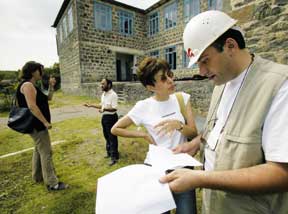 There are 72 villages located within four kilometres of the Georgian stretch of the BTC pipeline. It is in this narrow corridor - 248 km in length - that the most immediate and positive impact of the project is being felt, just months after the BTC consortium agreed to fund a $5 million social investment programme. "This is deliberate," says Eteri Kvirikashvili, the BTC Community Investment Programme (CIP) coordinator for Georgia. "From the beginning, we wanted to show that we meant what we said. There's wide mistrust in this country, and the only way to counter it is to do what we say we'll do as fast as we can, even before the pipeline is finished. This will enable us to develop relationships to benefit everyone." Lemshveniera is typical of the communities benefiting from BTC. Located in semi-desert terrain not far from the decaying industrial town of Rustavi, it is a poor settlement of Svans- people, originally from the high west Caucasus who moved after an earthquake destroyed their homes in the late - 1980s. Visited in March by representatives of Mercy Corps - one of two NGOs (non-governmental organizations) selected by BP to run the Georgian CIPs - the Svans were encouraged to come up with their own ideas related to the needs in their community. Several meetings later, a project was chosen and the community agreed to fund 30 percent of its cost in exchange for a $25,000 grant from BTC. Work began in late June. They chose an ambitious scheme to restore a derelict irrigation system by laying and welding 1,300 metres of new steel pipe across scrubland so that the whole village and their cattle could have access to water. Lemshveniera's old water system used electricity to run a pumping station. This was wrecked in the troubled 1990s. In addition, electricity is intermittent in Georgia today so the new system relies on gravity. "We're expecting our first crops of melons, water melons, apples and vegetables next year," notes Gogi Kaldani, the Svans' spokesman. "There's a tendency for villagers to be suspicious when strangers first arrive," says Nana Topuridze, the Mercy Corps Project Director who is involved with organizing the programme. "There's enormous mistrust of anyone perceived as being in authority. So you need to gain their trust and move quickly, take actions, get as many people as possible involved as soon as you can." And, as Topuridze also remarks, it's crucial to share information, publish budgets and insist on regular, open accounting. Along the pipeline corridor in Georgia, there are many stories like Lemshveniera's. Micro-financing loans from BTC are enabling groups in Rustavi and other places to start up small businesses, doing everything from trading goods to making shoes, sewing dresses, running mini-bus services and cutting hair. In Samshvilda, an isolated Armenian village near the town of Tetriskaro, $5,000 is being spent to replace a leaking, asbestos - contaminated school roof. At another village called Marabda, an $8,000 project, involves construction of an eight-kilometre trench from nearby hills so that 200 households can have access to running water. When this job is completed, something will be done about the heavily rutted road that runs through the village. The emphasis of nearly 70 initiatives like these in Georgia is clear and consistent - to make immediate improvements that are sustainable, defined by quality and maintenance. Each project is underpinned by a real commitment from the community - sometimes a funding pledge, sometimes the promise of free labour or long-term involvement. Frequently, it proves difficult to get communities that have little or nothing to prioritize their needs. But always the principle holds that villagers themselves must decide. Seed Collection David Kikodze, a botanist working at the Bukuriani botanical gardens not far from the BTC route in central Georgia, is a live-wire enthusiast. Words gush from him as he describes how a BP-sponsored project is helping to preserve rare and endangered plant species, growing in the right-of-way corridor that runs across Georgia. "Two surveys of the route have been done and two sites have been organised," he begins. "So far we've identified 10 species and collected more than 5,000 samples. The idea is to grow these plants in our gardens, germinate the seeds and eventually reintroduce the species back to their original locations in about three years." Sponsored by BP through a $240,000 grant that lasts to mid-2006 and covers all transplanting, seed collection and management of plants at the Bukuriani and Tbilisi botanical gardens, Kikodze and a small team, including an entire family displaced from Abkhazia (a breakaway part of Georgia) have built seven raised plant beds in the Bukuriani gardens, filled them with prepared soil, installed watering and drainage systems and rebuilt a greenhouse - all in less than six months. Rare species such as pasque flowers, fritillary, snowdrops, marsh orchids, squill, gential, globe daisy and oriental thorn are now safely growing in the lovingly-tended beds. "Our surveys didn't find any new species," says Kikodze. "But we have found some new locations where these species grow, and some of these plants are extremely rare." Awareness of this unusual project extends even to the Missouri Botanical Gardens in St. Louis, Missouri in the U.S. Such international interest in work at Bukuriani is nothing new. In 1912, the famous German botanist Adolf Engler visited the gardens and signed the visitor's book. Today, after a difficult decade during which the gardens lost two-thirds of their species, the sun once again is shining on one of nature's most precious assets. Turkish Community Programs In August, a $9 million budget was agreed upon by the BTC partners to finance four major community investment programmes in Turkey that are designed to contribute to sustainable rural development in four provinces - Ardahan, Kars, Erzurum, and Gumushane-Erzincan. A $3.3 million budget has also been set to support at least five initiatives to preserve biodiversity and protect endangered species and important bird and plant life along the BTC route. BTC's role will be to monitor and evaluate the projects, manage the funds, liaise with those carrying out the projects and provide support and training. Implementers include Ataturk University, the International Blue Crescent Foundation, the Sustainable Rural and Urban Development Society (SURKAL) and PAR Consulting. They are supported by the Middle East Technical University, Birdlife International, Royal Society for the Protection of Birds, Doga Dernegi and Istanbul University. The various programmes are aimed at communities living within the 4 km pipeline corridor. They will, BTC hopes, promote and empower community-level institutions and stimulate sustainable income-generating activities as well as help to rehabilitate the existing social infrastructure. In Ardahan, the project will target women, children, the unemployed and the uneducated. The goal is to help 37 communities increase employment by 10 percent by stimulating fruit production, boosting computer education, and offering agricultural and livestock training and information. The Kars project, extending to 20 villages, will focus on improving animal husbandry and community infrastructure such as sewerage and drinking water supplies. In Erzurum province, the project will concentrate on expanding crop cultivation in 20 villages, establishing trout farms in nine villages and organising organic agriculture and eco-tourism in 23 villages. Similarly, the Erzincan & Gumushane initiative will target activities likely to make immediate improvements such as livestock treatment, fodder crop cultivation, beekeeping and seed production. Among the environmental investment projects planned are investigations into a number of rare and threatened species such as the black grouse, sea turtles and the Mediterranean monk seal, as well as surveys designed to discover more about key plant and bird areas along the pipeline route. The need for such projects has been well documented in prior studies sponsored by the BTC Company. Unemployment and poverty levels are high in each of the four provinces that are being targeted. Earnings are low, power supplies are inadequate and infrastructure and services are often lacking. Advisory Panel The first report produced by the Caspian Development Advisory Panel (CDAP) was issued in August 2003. Covering the social, environmental and economic impact of the BTC project related to Azerbaijan and Georgia, it includes more than 60 recommendations in six areas: sustainable development, small/medium size enterprises, Georgia's access to energy, transparency, the project's legal regime, and monitoring. The CDAP was set up by BP to provide independent advice on its projects in the region as part of a commitment to extensive public consultation. One of CDAP's most innovative recommendations is that all existing BTC community, social and environmental investment progammes in Azerbaijan, Georgia and Turkey be combined into a Caspian Development Fund set up to last the lifetime of the project. The Panel believes that such a Fund should be run on a non-profit basis and have funds at its disposal significantly in excess of the $30 million already committed by the BTC consortium. In addition the Panel recommends that a structured, community-based monitoring mechanism be established in Georgia's Borjomi region, perhaps along the lines of the regional citizens advisory councils set up in Alaska to foster dialogue between the community, regulators and oil companies. Other key recommendations include: (1) Increased attention to platform decommissioning issues; (2) More direct BP/ BTC involvement in land compensation payments; (3) Greater effort to clarify legal issues such as the environmental and safety standards being followed by the project. The Panel also endorses various Amnesty International suggestions including the need for confirmation that nothing in the BTC/SCP legal regimes will make it harder for host governments to satisfy international human rights obligations. In response, BP welcomed the CDAP report, and stated that it shared the Panel's vision that the Caspian projects have the potential to "create a model for investments in extractive industries that will leave a lasting positive legacy in the host countries," and noted that the CDAP recognised the steps the consortium had already taken to this end. It also accepted many of the recommendations, including the need for new measures to strengthen small and medium sized enterprises and for transparency. In the future, it stated, BP would "publish an annual report, providing information on payments to governments, projections of future earnings and our social and environmental performance, subject to host government and partner agreement." Additionally, it committed to publish "a plain-language summary" of the various project agreements with the three host governments and stated that it was reviewing the option of establishing monitoring panels similar to those in Alaska. In October, CDAP expects to report its interim findings on Turkey. The entire interim report on Azerbaijan and Georgia, and BP's response, is available on the BTC Web site: caspiandevelopmentandexport.com, and also on the CDAP website: caspsea.com The BTC website-recently upgraded and made easier to navigate-contains a regularly updated news service, press releases, a site answering frequently asked questions (FAQs), and all documentation that has been released for public examination. Back to Index AI 11.3 (Autumn 2003) AI Home | Search | Magazine Choice | Topics | AI Store | Contact us Other Web sites created by Azerbaijan International AZgallery.org | AZERI.org | HAJIBEYOV.com |


